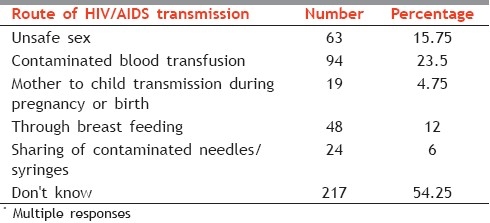Sir,
Globally, 10.3 million youth in the age group of 15-24 years are living with human immunodeficiency virus/acquired immunodeficiency syndrome (HIV/AIDS). India is one of the largest and most populated countries in the world where adolescents constitute about 22% of the total population. As per estimate of 2009, in India, 2.4 million people were living with HIV.[1] Out of total cases of HIV/AIDS in India, 35% were in the age group of 15-24 years and most of them were infected through unprotected sex. The United Nations International Children's Emergency Fund (UNICEF) statistics (2003-2008) found that only 20% of the adolescent females are aware about the comprehensive knowledge on HIV/AIDS, while the percentage in male counterpart is about 36%. This underlines the vulnerability of female adolescent to HIV/AIDS.[2] The adolescents living in slum areas are more vulnerable for HIV/AIDS due to poor access to education, migration, poverty etc.[3]
A community based cross sectional study was conducted in the urban slum areas of Solapur Municipal Corporation (Western Maharashtra) during June 2010 to August 2010. Total 400 adolescent girls in the age group of 13-19 years were included in the study. The required sample size was estimated by the formula 4 pq/L2(p-positive character q=100-p/ l-allowable error) (here, p=0.2, q=1-p and L= allowable error at 5%).[2] Out of 127 slums registered under Municipal corporation area, 10 slums were selected by lottery method. Forty respondents from each slum were selected by simple random sampling method. If the respondents were found less in a particular slum area then the remaining were covered in next big slum area. The data was collected with the help of pre-tested and pre-designed performa by skilled social workers taking the informed consent from the adolescent girls. Before taking the interview, briefing was done about the questions asked for e.g., what is the meaning of unsafe sex etc. and the information was collected.
In the present study of 400 adolescent girls, 102 (25.5%) were in the age group of 13-14 years, 115 (28.75%) and 183 (45.75%) were in the age group 15-16 years and 17 years and above, respectively. The mean age of the respondents was 15.92 ± 2.33 years. Out of the 400 adolescent girls, 63 (15.75%) said that HIV/AIDS transmits through unsafe sex, 94 (23.5%) through contaminated blood transfusion, 19 (4.75%) through mother to child during pregnancy and child birth, 48 (12%) through breast feeding, 24 (6%) by sharing contaminated needles/syringes, and 217 (54.25%) were not aware exactly how HIV/AIDS transmits from one person to another. As shown in Table 1, HIV/AIDS transmits through unsafe sex was told by 6.86% girls in the age group of 13-14 years, while the percentage was 13.04% and 22.40% in the age group of 15-16 years and 17 years and above, respectively (P<0.0008). Statements such as HIV/AIDS transmits from mother to child during pregnancy, child birth or after birth through breastfeeding were significantly told by the girls in the age group of 17 years and above (P<0.001), as shown in Table 2.
Table 1.
Knowledge of HIV/AIDS transmission among adolescent girls (N=400)*

Table 2.
Assessment of HIV/AIDS knowledge in relation with age

Kotecha P.V. et al.[4] and Alexandra McManus et al.[5] found that only 19.2% and 33% school going girls were not ware about HIV/AIDS transmission, while the percenatge in the present study was 54.25%. A total of 15.75% girls in the present study said that HIV/AIDS transmits through unsafe sex. While the percentage stated by Kotecha P.V. et al.[4] was 74.6% which was higher than present study. It underlines the vulnerability of adolescent girls for HIV/AIDS due to poor knowledge of safe sex. A total of 23.5% girls in the present study said HIV/AIDS transmits through contaminated blood transfusion. Similar finding was noted by Kotecha P.V. et al.[4] (18.5%) but higher percentage was noted by Payal Mahajan et al.[6] (32.5%). A total of 4.75% girls responded that HIV can be transmitted from mother to child, while the percentage noted by Kotecha P.V. et al.[4] was 17.7% which was higher than the present study. Thus, poor knowledge in adolescents about HIV/AIDS transmission was a serious concern as found in the present study. There is a great need to formulate the information, education, and communication (IEC) strategies focusing on individual level, family level, and community level.
ACKNOWLEDGEMENT
I am thankful to Dr.Shasikant Ahankari, President HALO Medical Foundation Anadur, Dist. Osmanabad for providing us Medical Social Workers for data collection.
REFERENCES
- 1.Overview of HIV and AIDS in India. [Last cited on 2011 Apr 20]. Available from: http://www.avert.org/aidsindia.htm .
- 2.Naswa S, Marfatia YS. Adolescent HIV/AIDS: Issues and challenges. Indian J Sex Transm Dis. 2010;31:1–10. doi: 10.4103/2589-0557.68993. [DOI] [PMC free article] [PubMed] [Google Scholar]
- 3.Erulkar AS, Mekbib TA, Simie N, Gulema T. Migration and Vulnerability among Adolescents in Slum Areas of Addis Ababa, Ethiopia. J Youth Stud. 2006;9:361–74. [Google Scholar]
- 4.Kotecha PV, Patel S, Makwana B, Diwanji M. Measuring knowledge about HIV among youth: A survey for Vadodara district. Indian J Dermatol Venereol Leprol. 2011;77:252. doi: 10.4103/0378-6323.77489. [DOI] [PubMed] [Google Scholar]
- 5.McManus A, Dhar L. Study of knowledge, perception and attitude of adolescent girls towards STIs/HIV, safer sex and sex education: (A cross sectional survey of urban adolescent school girls in South Delhi, India) BMC Women's Health. 2008;8:12. doi: 10.1186/1472-6874-8-12. [DOI] [PMC free article] [PubMed] [Google Scholar]
- 6.Mahajan P, Sharma N. Awareness level of adolescent girls regarding HIV/AIDS (A comparative study of rural and urban areas of Jammu) J Hum Ecol. 2005;17:313–4. [Google Scholar]


